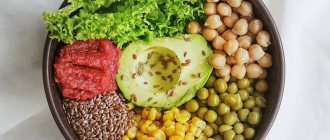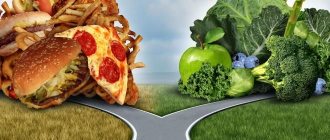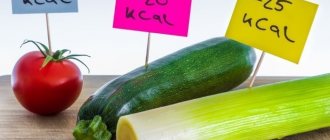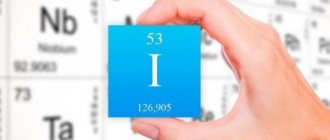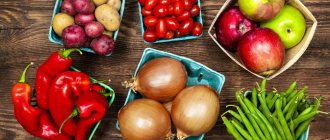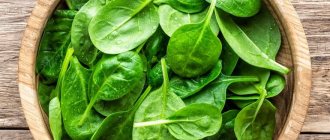Slow glucose (low GI) is beneficial. Eat these carbohydrates every day, even on the most restrictive diet. Forget about counting calories! Allow yourself “healthy” foods without regard to calorie content.
The energy for the activity and vitality of a healthy person’s body always comes from food. Most of the energy needs are met by foods rich in carbohydrates. Carbohydrates are traditionally divided into fast and slow. They are also called simple and complex (or complex). Weight loss occurs if you exclude a maximum of simple “bad” carbohydrates from your diet, leaving “good” carbohydrates on the menu.
Fats, proteins and carbohydrates - what goes with what
Nutritionists have long divided all the products on the human dining table into three general groups:
- Protein food
- Fats
- Carbohydrates
The first includes meat and fish in any form, eggs of all types of birds, legumes, and various nuts. The most powerful and at the same time dangerous source of energy in terms of calorie content are heavy animal fats and vegetable-based oils (including refined ones). Fat enters the body with fish and dairy products, meat and eggs. Finally, carbohydrate-containing products are all types of flour products, sugar and all variety of sweets, potatoes, and cereals. Carbohydrates are in no way compatible with proteins and vice versa.
The main difference between the former and the latter is that for proper digestion of a protein product in the stomach and its high-quality breakdown, the gastrointestinal tract must have an acidic environment, and in order for carbohydrate-type food to be properly absorbed by the body, the environment in the stomach must become alkaline. Thus, when these incompatible food groups are combined on your plate, your stomach will either ignore the first when digesting it, or will not digest the second. This threatens regular digestive disorders, disruptions in the gastrointestinal tract, decreased metabolic rate, diabetes mellitus and negative weight fluctuations.
But the third group - fats - is compatible with both the first and second, but is categorically not recommended for a person losing weight. True, only in some of its product variations. Despite the persistent associations of fatty foods with French fries and hamburgers and, as a result, with extra pounds and blurred waistlines, the “right” fat (which is unsaturated fatty acids) is able to burn out the most hopeless fat deposits from the body. Healthy sources of unsaturated fats include: avocado, fish and white meat, nuts and natural vegetable oils (first and second pressing).
What are bad and good carbohydrates
Carbohydrates are organic compounds of carbon and water. The human body will not function fully without regular carbohydrate feeding. Without the intake of carbohydrates, the internal organs will not be able to process either fats or proteins and the liver, the most important organ for enriching blood cells with the necessary substances, will cease to function properly.
Carbohydrates are the main supplier of food for the mind - glucose for the brain.
The division into slow/fast carbohydrates is directly related to the speed of their breakdown by the body and the time of transformation into nutritious glucose. By the way, glucose is precisely the main irreplaceable energy source for the body.
To measure the speed of a car, the mileage traveled is used, divided by the time unit hour - kilometers per hour. To indicate the rate of breakdown of glucose, an equally interesting measurement value has been introduced - the glycemic index.
Feelings from eating slow and fast types
The sensations from eating slow and fast carbohydrates vary significantly . Try observing how you feel after eating foods rich in these compounds. If within half an hour you feel a surge of energy, then these were fast (simple) carbohydrates. It is important to understand that this sensation often passes with unpleasant consequences caused by a surge in insulin levels. If after eating you did not experience a sharp surge of energy, but the feeling of hunger does not return for a long time after such a meal, then you consumed slow carbohydrates. They allow you to provide the body with energy for a longer period, although the fast type of connections is sometimes useful for giving strength to the body in case of overload and the need for quick mobilization.
List of foods with healthy carbohydrates (and glycemic index below 40):
- brown and colored long rice
- unprocessed rice
- wholemeal bread products
- whole wheat noodles
- all types of cereals, with the exception of semolina
- fresh or frozen zucchini
- green spinach and other greens from the garden
- all types of cabbage
- sour fruits (fresh kiwi and grapefruit, orange, and green apple)
- boiled red and green lentils
- all types of soybeans
- beans, beans
- barley porridge
- dried apricots
- plums with peaches
- ripe avocados
- fresh bell and chili peppers
- onions of all types - yellow, red, leek and others
- processed edible mushrooms
- juicy fresh tomatoes
How “proper” carbohydrates work
Once in the body with food, they are absorbed into the walls of the gastrointestinal tract and slowly raise blood sugar levels. There are no glucose surges in the body, the person’s mood and condition remain stable and even. In general, don’t want to be considered a nervous and fussy person? Adjust your diet towards the healthiest “slow” carbohydrates.
It is noteworthy that a person starts digesting this type of carbohydrate from the first piece of product that enters the mouth. This is facilitated by a special enzyme produced by human saliva. Therefore, no to stress, yes to weight loss and peace!
Connection types
Carbohydrates are often divided into two groups as follows:
- Fast and slow carbohydrates.
- Simple and complex.
- Harmful and useful.
Let's figure out where this classification comes from. The effect of a particular type of these compounds depends on its chemical structure. These compounds are sugar molecules of different natures connected to each other. All of them are eventually broken down by the body into glucose. It serves as a source of energy for all types of cells in the body.
What are slow carbohydrates? Typically, the more complex the bonds between sugar molecules, the more complex, beneficial, and slower (in terms of digestion speed) they are. There are three types of these compounds, differing in the number of sugar molecules they contain:
- Monosaccharides consist of one sugar molecule. Monosaccharides include glucose, galactose and fructose.
- Disaccharides consist of 2 sugar molecules. Examples of disaccharides are sucrose (table sugar), lactose and maltose.
- Polysaccharides are made up of several sugar molecules. Polysaccharides are found in pasta, potatoes, cereals and many other foods.
The simple (fast) type of carbohydrate compounds are monosaccharides and disaccharides. Due to their simple molecular structure, they are easily digested, and the products of their metabolism quickly enter the bloodstream. This type is present, for example, in fruits, milk, and sweets.
Slow or long-term carbohydrates (complex) are polysaccharides that, due to their complex molecular structure, are broken down more slowly in the digestive tract. This type is found in large quantities in grains and vegetables. You may think that fast carbs are bad and slow carbs are good. But everything is not so simple, so let’s look at why the body needs fast and complex carbohydrates.
"Wrong" carbohydrates
As it becomes clear from the explanation of the effectiveness of carbohydrates with an eye to the speed of their absorption, fast carbohydrates (or “death to the diet”) are those that have a high glycemic index. They, of course, are also saturated with a number of vitamins, and they contain microelements. But they have much less benefit than low-index carbohydrates. Therefore, it is not recommended for those who want to lose weight to allow themselves to do so every day. By the way, this type of carbohydrate includes alcohol, which is unloved by nutritionists, in all its variations.
But if you can’t do without “wrong” carbohydrates, then allow yourself delicious desserts, delicious pastries, relaxation with a glass, at least in the format of a very rare “holiday”. Remember, more frequent concessions to your “I want and I will” do more damage not to your waist width, but to your health in general. Thus, the pancreas, which is responsible for the production and supply of insulin, begins to work at the limit of its capabilities as soon as the body is overloaded with such “wrong” carbohydrate foods. As a result, blood sugar jumps, the mood changes from cheerful to tearful, the brain plunges into despondency, and the stressful state and gloomy tension do not go away even after “treatment” with chocolate-covered buns.
Stimulation by serotonin (the hormone of happiness) from the consumption of carbohydrate foods can be avoided to the point of absurdity if you heed the advice of doctors. Cheer yourself up (occasionally) with the following foods.
Fiber-rich foods
Fiber is the only subclass of carbohydrates that does not break down into monosaccharides. Its function and role is significantly different from the tasks of other carbohydrates, so products containing carbohydrates, such as cellulose, lignin, pectin and others, should be listed separately.
The consumption rate is 25-30 grams per day. List of leaders in fiber content:
- Bran and cake of various oilseeds - the maximum possible amount.
- Whole grain products: wholemeal bread, whole grains.
- Fresh vegetables, a little less fruits and berries. After heat treatment, the fiber content in them decreases sharply - almost twofold. Legumes are especially rich in fiber: peas, beans, etc.
- Nuts and dried fruits.
Fiber, unlike other polysaccharides, does not replenish the energy balance, but serves as a good “brush” for the intestines and normalizes digestive processes. It is in demand among those who create a menu for weight loss, because it promotes a feeling of fullness, even if the portion is small.
List of foods with a glycemic index above 60:
- honey, propolis, bee waste products
- fresh and canned candied pineapples
- dried raisins
- watermelon
- Yellow banana
- sugar melon
- sweet dates
- pancakes, including store-bought ones
- crackers
- sweet corn flour sticks
- corn flakes, including for children
- instant porridge (oatmeal, etc.)
- potatoes baked in the oven or in the coals of a fire
- homemade/instant potato puree
- boiled carrots
- turnip
- all types of pumpkin fruits and desserts
- white rice
- grain and white bread
- cookies
- couscous, including coarse wheat flour
- semolina
- dry prepared food products (industrial production adds pure carbohydrates - sugar/glucose, as well as starch) to already processed products.
How to lose weight with carbohydrates, proteins, fats
Knowledge is power, and separate nutrition is power, assure crowds of men and women who have achieved ideal indicators on the scales thanks to the separate nutrition system. The main advantage of separate nutrition is the absence of strict prohibitions, and therefore, breakdowns. The creator of the system is Dr. Herbert Shelton, famous in the twentieth century.
So, the rules of separate nutrition (or carbohydrate-protein diet):
- Never eat proteins with carbohydrates. The latter should be put into the mouth no earlier than three to four hours after eating protein food.
- A carbohydrate food is one that contains at least 20% carbohydrates. A protein product is one that contains more than 10% protein.
- One meal should contain only 3-4 foods, either protein or carbohydrate. Are you planning to have a healthy vegetable salad for lunch? And it should be prepared with no more than 2-3 ingredients!
- Planning a protein lunch or dinner? Supplement it with a freshly chopped vegetable salad without starch (for example, Chinese cabbage, fresh cucumber, juicy radish, red-sided tomato).
- Avoid combining carbohydrate foods with a GI above 60 with foods containing acids (lemon, apple, grapefruit, tomato).
- Acidic foods are also incompatible with raisins (cottage cheese, fish, etc.).
- If giving up sugar is very difficult, replace it with bee products. Don’t be cunning and buy food with “unnoticeable” sugars.
- No mono diet! No monotonous diet, otherwise there is a high risk of serious harm to your health. On one day, alternate meals as much as possible in different meals.
- Do you want some bread? Eat! But not as a snack to chicken broth or vegetable salad, but as a separate independent product - an autonomous meal.
- For pregnant women, any food experiments and diets are completely prohibited. Restrictions on food and adjustments to the diet of an expectant or nursing mother should occur under the strict supervision of a supervising physician.
The most useful foods containing monosaccharides
The list below shows the most beneficial foods for weight loss that contain large amounts of simple carbohydrates. They successfully satisfy the craving for sweets and will be especially useful for those who cannot live a day without something tasty.
- Honey 80.3 grams per 100 grams of product. Almost pure sugar, only with healing properties.
- Grapes (17 g) - grapes have practically healing properties, on which a whole branch of therapeutic medicine is based - ampelotherapy.
- Fresh rose hips (24 g), dried rose hips (60 g). The leader among berries, it is ahead of currants, raspberries, strawberries and other berries in terms of carbohydrate content. In addition, it has a record amount of vitamin C.
- Dates - contain 72.1 g of mono- and disaccharides and many vitamins. Sacred food in Muslim countries, they are so tasty and healthy.
- Dried apricots - the carbohydrate content in it can reach 80 g; fresh apricots contain 10.5 g, which is also quite a lot compared to other fresh fruits.
- Seedless raisins (71.2 g) - have amazing properties, even to the point that they can reduce fat deposited on the waist.
- Prunes are also one of the sweetest dried fruits (64.6 grams) and a known laxative.
- Fresh apples contain 11.3 g, dried - 68 g, an excellent source of iron, fiber, vitamins, and pectin.
- Watermelon (8 g) - mostly fructose. In addition to an excellent set of vitamins, watermelon contains a phenomenal amount of lycopene, a very strong antioxidant.
- Carrots (7 g) are a constant participant in mono-diets and have many healing properties.
Common truths of losing weight
- Eliminate any sugars from your diet.
- Forget about flour and baked goods made from premium flour.
- Throw all purchased processed foods in the trash.
- There is no need for energy bars for athletes; they are easily replaced with natural “correct” carbohydrate products.
- Monitor your blood insulin levels. Its low level starts the fat burning process.
- Carbohydrates - for breakfast, for energy, activity, sports.
- If you have a choice between proteins or carbohydrates for dinner, take proteins (fish, cottage cheese, eggs). This way, insulin will remain at its previous level (there are no sweets on the dinner menu), and the weight loss process will continue even in your sleep!
It is noteworthy that during separate meals you will not have to try to overcome the constant feeling of hunger. You will eat quite normally and eat as much as you need to feel full. You will not experience mood swings, the desire to take a nap, irritability and fatigue.
Without sacrifices, financial costs, psychological breakdowns, and most importantly - practically without effort, you will begin to lose weight and become more active and cheerful!
3 dinners for two with free delivery for RUB 1,990.
View menu
Insulin diet - how to sleep and lose weight
The diet involves consuming foods with different glycemic indexes, but strictly according to the schedule. Then the insulin level will not rise sharply, and during sleep the body will process fat reserves and lose weight. The mode is as follows:
- 6-10 a.m. - physical activity, breakfast with dishes with a high glycemic index;
- 10-14 hours - medium exercise, lunch from dishes with a medium and low glycemic index;
- 14-18 hours - light activity, low-carb dinner;
- night - food processing.
